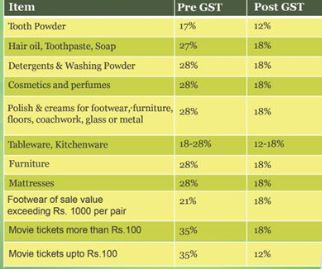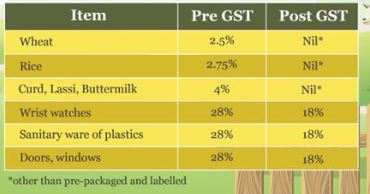Seven years of GST saw reduced prices of daily consumables
New Delhi [India], July 1 (ANI): Hair oil, toothpaste, soap; detergents and washing powder; wheat; rice; curd, lassi, buttermilk; wrist watches; TV upto 32 inches; refrigators; washing machines, mobile phones, are among key items on which GST rates have been slashed substantially, or for some kept at zero, benefiting people of this country.
A Finance Ministry study suggested that consumers saved at least four per cent of their household monthly expenses on an aggregate after GST. Thus, consumers now spend less on daily consumables like cereals, edible oils, sugar, sweets and snacks.
Following are tables listing out goods on which GST rates have been reduced:



Goods and Services Tax (GST), a key tax reform in India’s history, has turned seven years on Monday. In the intervening period, many consumer-centric moves were taken under this new taxation regime.
The biggest tax reform GST was rolled out on July 1, 2017, removing the inefficiencies and complexities of the previous archaic taxation system. Over the years, GST has, among others, simplified compliance and reduced the cascading impact of tax.
The Government has progressively lowered tax rates on essential and daily-use items.
A range of decisions were taken in the GST Council with the consensus of the states and Union territories, benefitting households in one or the other way. GST Council has from time to time slashed taxes on key consumer goods of daily use, supporting household budgeting.
The GST Council, a federal body comprising the Union Finance Minister as its Chairman and Finance Ministers of all States as members, has played its part in the forum.
Before July 1, 2017, the indirect tax regime was highly fragmented. The Centre and States were separately taxing goods and services.
There were many taxes like excise duty, service tax, VAT, CST, purchase tax, and entertainment tax, putting a multiple layer of burden on consumers.
GST also subsumed large taxes and several cesses. It brought uniformity in the tax structure across India, eliminating the cascading effect of taxes. GST includes Central GST (CGST) and State GST (SGST), with Integrated GST (IGST) for interstate transactions.
Under GST, businesses can claim credit for taxes paid on inputs, avoiding double taxation.
In the earlier system, there was a multiplicity of rates, laws and procedures. This caused a heavy compliance burden. There used to be tax gates at every inter-state border, creating bottlenecks in the inter-state transport of goods.
The industry’s choice of locating factories or warehouses was heavily influenced by the prevailing tax regime rather than pure business consideration, making the industry uncompetitive.
In 2,000, the then government had conceptualized GST and had set up a committee to design a GST model.
In the GST system, the salient features among those mentioned above are that it ensured compliance simplification with uniform processes across the country, a simple registration process – Single return – Minimal physical interface, faster refunds, a fully IT-driven system, free flow of goods – check posts removed.






